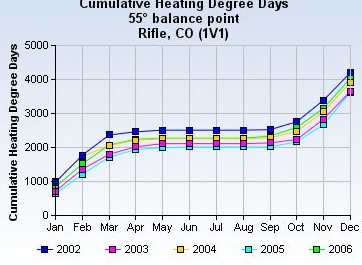
Search
The Renewable Energy site for Do-It-Yourselfers
Heating Degree Day Help
Heating Degree Days are a measure of
how cold your climate is. If the average outside temperature for a day is
1 degree less than the inside temperature, then you would accumulate 1 degree
day on that day. If the average outside temperature was 20 degrees below
the inside temperature, then you would accumulate 20 degree days on that day --
and so on. Heating Degree Days accumulated for a full year
range from 140 for a warm place like Miami, to 14,000 for a cold place like
Fairbanks. The higher the number of degree days for your climate, the more
you will save by adding insulation.
One thing to be careful of is that
degree days can be in Fahrenheit or Celsius. You need the Fahrenheit
number for the insulation calculator, so if you look up a Celsius number, you
must multiply this by 1.8 to convert it to Fahrenheit.
For the US, the simplest way to get a
reasonable estimate of degree days for your area is to pick it off this map:
Heating Degree Day Map of US (130K)
This very handy and easy to use degree-day web based tool provides historic and
current degree day information of 1200 locations:
http://www.energycap.com/weather/
Note: that the default balance point for
these charts is 55F. Most sources use a balance point temperature of 65F.
You can change the balance point to 65F in the form.

A list
of Heating Degree Days for US cities:
http://www.ncdc.noaa.gov/oa/climate/online/ccd/nrmhdd.txt
More detailed historical weather
(including degree days) can be downloaded for many US city here:
http://cdo.ncdc.noaa.gov/cgi-bin/climatenormals/climatenormals.pl?directive=prod_select2&prodtype=CLIM20&subrnum=
Or, just search
http://cdo.ncdc.noaa.gov for the CLIM20
report.
You can also contact a weather office
near you, and ask them for the local yearly degree day number. Contact
information for weather offices in the US can be found here:
http://www.nws.noaa.gov/organization.php Look for the Contact Us link
in the menu on the left.
For any location in the world, NASA
provides yearly degree day estimates from satellite data here:
http://eosweb.larc.nasa.gov/cgi-bin/sse/sse.cgi?na+s01#s01
A new tool that provides world wide
degree-day data based on Weather Underground stations is available here:
http://www.degreedays.net/
Since it is based on Weather
Underground reporting stations, it may have a location closer to you than other
sources.
Gary Updated May 19, 2008

